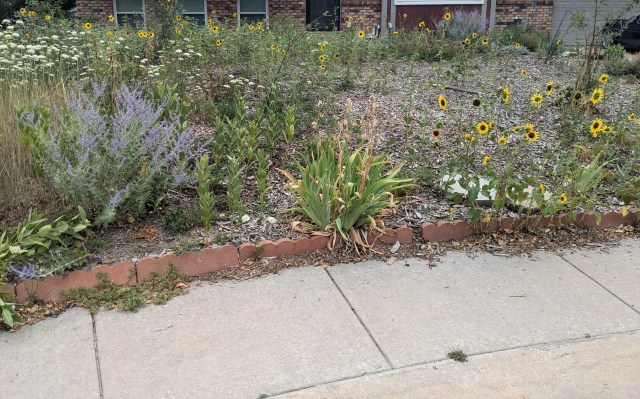A homeowner in Colorado showcased the wild beauty of their native plant yard, making an excellent case for switching up your garden plans.
In the r/NoLawns subreddit, the homeowner shared several photos of their yard, featuring a variety of blooming plants, including sunflowers, yarrow, and Russian sage. They also have plants that bloom at other times of the year, such as daffodils, irises, milkweed, goldenrod, ice plants, Lilacs, lavender, and blue flax, as well as apple trees.

They explained that they, "mulched the whole yard several years ago, a foot or two deep in some spots," as part of their transition to a native plant lawn. "Hoping to fill in with more natives in the coming years!" they added.
The Redditor also noted they paid attention to the USDA Hardiness Zone Map, saying they live in Zone 5b at 6,500-foot altitude. The USDA Hardiness Zone Map is a guide to the conditions in your area that can impact plant growth, such as light, rainfall, humidity, and cold exposure.
The Cool Down's guides to rewilding your yard and switching to a natural lawn are also a great place to start for creating your own wild yard.
Understanding how to grow a native garden is amazing for saving water and, in turn, saving money on your utility bills, since native plants require less additional watering.
The Environmental Protection Agency reports that 30% of American water usage is spent on outdoor uses. It can climb to 60% in drier climates, and as much as 50% of the water used outdoors is wasted with inefficient watering methods.
The homeowner is clearly taking watering into consideration by some clever planting. For example, one person in the comments asked if the homeowner's ice plant is drought-tolerant, to which they responded: "They seem to be. Ours are always close to the house so they probably get more runoff and water than a lot of the yard."
Native plants also encourage pollinators, such as bees, butterflies, other insects, and even birds, all of which contribute to a healthy growing environment in the wild and agriculturally.
🗣️ If you were to switch from a grass lawn to a more natural option, which of these factors would be your primary motivation?
🔘 Making it look better 🌱
🔘 Saving money on water and maintenance 💰
🔘 Helping pollinators 🐝
🔘 No way I ever get rid of my lawn 🚫
🗳️ Click your choice to see results and speak your mind
People were wowed in the comments and had helpful suggestions to continue the homeowner's wild garden.
"Great start! Add some native grasses, water them the first year or two and you will have more of a 'meadow' look, plus winter interest," one person wrote.
Join our free newsletter for easy tips to save more and waste less, and don't miss this cool list of easy ways to help yourself while helping the planet.









